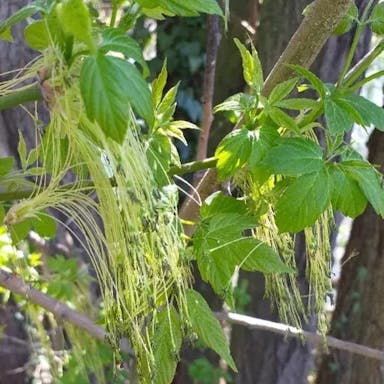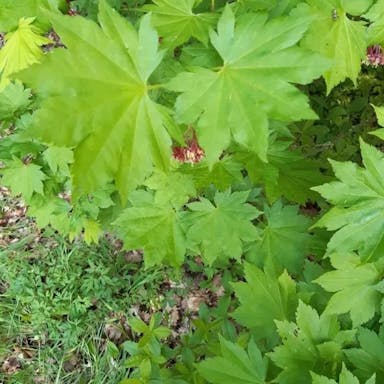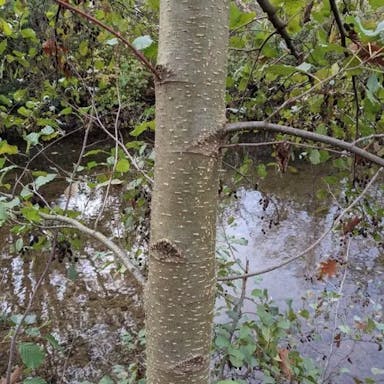White alder, scientifically known as Alnus rhombifolia, is a deciduous tree native to western North America. It is a member of the Betulaceae family and is commonly found in riparian habitats, such as stream banks and wetlands. The tree can reach heights of up to 80 feet and has a spreading crown with a diameter of 30 to 40 feet. The foliage of Alnus rhombifolia are placed alternately, have an uncomplicated shape, and are diamondlike, thus explaining the species name
White alder
- Scientific name
- Alnus rhombifolia
Basic Information
- Betulaceae Family Alnus Genus White alder Species
- Betulaceae > Alnus > Alnus rhombifolia
- 83%
- The Completeness of This Encyclopedia
Please help us complete the encyclopedia, Terrarium is a encyclopedia service to be completed with everyone in the world. Currently, this page is 83% complete. For more information on how to contribute, please click here.
- Broad-leaved tree
- Indeciduous tree
- Tree
- Height
- 1500cm ~
- Flower Color
- Leaf Color
- Anthesis
- spring
- Sunlight Exposure
Full Sun Long hours of sunlight from morning to afternoon Partial Shade A location in the shade of a tree or where either the morning or afternoon is shaded Full Shade A place where there is no direct sunlight
- Full Sun
- Hardiness Zones
This is an indicator to know to which zone each plant can winter. Knowing the zone of each plant gives you an idea of the cold temperature resistance when grown in the ground without a roof. 2: -42.7 to -40.0 3: -39.9 to -34.4 4: -34.3 to -28.9 5: -28.8 to -23.3 6: -23.2 to -17.8 7: -17.7 to -12.2 8: -12.1 to -6.7 9: -6.6 to -1.1 10: -1.0 to 4.4 11: 4.5 to 10.0
- 7
- Cold resistance
- Excellent
- Heat resistance
- Fair
- Habitat of origin
- United States
- Growth Rate
- Fast
What is White alder (Alnus rhombifolia)?
What is White alder (Alnus rhombifolia)
Flower meaning
The flower language commonly used in America for the plant called White alder is Endurance or Strength. Examples of the language of flowers include: - Red rose: Love and passion - Lily of the valley: Happiness and humility - Sunflower: Adoration and loyalty The White alder symbolizes the ability to endure challenges and keep going despite hardships. It represents perseverance and resilience. Its hardiness and stamina make it an emblem of fortitude and willpower. The meanings of flowers can differ based on place and time.
Calendar of White alder (Alnus rhombifolia)
Calendar
White alder, scientifically known as Alnus rhombifolia, is a deciduous tree native to the United States. The tree requires a sufficient amount of sunlight and water to bloom successfully. For division, it is recommended to provide adequate moisture and ensure proper drainage. Pruning the tree during the dormant season can help promote better flowering in the following year. Leaf cutting is a technique used to propagate plants from cuttings. Overall, White alder adds aesthetic value to landscapes during its blooming season.
How to grow White alder (Alnus rhombifolia)
Watering
White alder, scientifically known as Alnus rhombifolia, requires regular watering to thrive. This plant grows during spring to fall. Watering once a week to 10 days keeps the soil moist, not soggy. Apply water slowly at the base. This helps roots grow well and handle dry times. In winter, water every 2-3 weeks. Check soil. Adjust as needed. Proper moisture and deep watering keeps this plant healthy.
Soil and Fertilizer
White alder, scientifically known as Alnus rhombifolia, thrives in moist, well-drained soils. It prefers loamy or sandy soils with a certain pH range. The soil should be rich in organic things and have good ability to hold water. To ensure optimal growth, it is advised to apply a balanced mix of nitrogen, phosphorus, and potassium. The mix should be applied in spring before new growth starts and again later in spring or early summer. How much mix to apply depends on the plant's size and age. For young plants, apply around 1/4 to 1/2 pound per plant. For mature trees, use 1 to 2 pounds per tree. It is key to spread the mix evenly around the base, avoiding direct contact with the trunk. After applying, thoroughly water in the mix to ensure proper absorption by the roots. Checking the soil regularly is encouraged to monitor nutrient levels and pH. Adjustments to applying the mix can be made based on the test results to keep optimal soil conditions.
Sunlight and Place
White alder (Alnus rhombifolia) is a plant species that exhibits moderate cold tolerance, making it suitable for regions with mild to moderate winter temperatures. The plant can withstand temperatures as low as -10°C (14°F) without significant damage. However, it may not be well-suited for areas with extremely cold winters. In terms of heat tolerance, White alder is relatively adaptable and can withstand high temperatures up to 40°C (104°F). It is considered to have a moderate heat tolerance, allowing it to thrive in a wide range of climates. The plant prefers an optimum temperature range of 15-25°C (59-77°F) for optimal growth. It can tolerate slightly higher or lower temperatures, but prolonged exposure to temperatures outside this range may affect its overall health and vigor. During the summer, the plant benefits from regular watering to maintain adequate moisture levels in the soil. Well-drained soil is important to prevent waterlogging, which can be detrimental to the root system. In terms of sunlight, the plant thrives in full sun exposure. It requires a minimum of 6-8 hours of direct sunlight per day to ensure proper growth and development. Insufficient sunlight may result in weak and leggy growth. In summary, the plant species has moderate cold and heat tolerance with an optimum temperature range of 15-25°C (59-77°F). It requires full sun exposure, with a minimum of 6-8 hours of direct sunlight per day. Proper watering and well-drained soil are essential for its overall health and vigor.
Advanced Information of White alder (Alnus rhombifolia)
Pruning
White alder, known as Alnus rhombifolia, needs regular care. Maintaining health, shape, and size requires pruning. Removing branches keeps the tree healthy. It encourages new growth and air flow. Prune in late winter or early spring before buds form. The tree resists disease and insects then. Use clean, sharp tools. Make smooth cuts to avoid harm. Take out unwanted or tangled branches. Open up dense areas for light. Cut outside branch collars for healing. After pruning, remove debris to stop disease spread. Apply mulch to hold moisture. It also prevents weeds. Regular, proper pruning sustains white alder's health and form.
Planting and Harvest
White alder, scientifically known as Alnus rhombifolia, is a deciduous tree native to western North America. Pink meadowsweet is fragrant, tolerates damp conditions, attracts bees, butterflies and other beneficial insects. When it comes to potting this plant keep the soil evenly moist to promote flowering. This hardy shrub enjoys full sunshine, but can handle light shade. For the best floral display provide average to moist soil and full sun. Divide established clumps every 2-3 years in early spring or fall. Water-logging or compaction causes chlorosis. Provide compost enriched soil to aid bloom. Deadhead spent flowers regularly to prolong flowering . Regular pruning keeps plants shapely. Allow suckers at the base to remain for thick growth. This plant can suffer from few pests and diseases when planted in ideal conditions. In conclusion, pink meadowsweet prefers damp soil and performs poorly in dry or arid climates.
Propagation
White alder can be propagated by several methods including sowing seeds, division, cuttings, and leaf cuttings. To propagate by sowing seeds, gather fully developed seeds from the plant and place them in a well-draining potting mix. Keep the mixture moist and give filtered sunlight. Germination generally takes 2-3 weeks. For division, carefully separate the alder into smaller sections, ensuring each section has attached roots. Put the divisions in individual containers or directly in the ground, keeping the soil moist until they establish. To propagate by cuttings, take 4-6 inch long stem cuttings from the alder. Remove the lower leaves and dip the cut end in rooting hormone. Put the cuttings in a well-draining potting mix and keep them in a warm, humid environment. Rooting usually occurs within 4-6 weeks. Leaf cuttings can also be utilized for propagation. Take healthy leaves and cut them into small sections. Place the leaf sections on a moist potting mixture and lightly press them down. Keep the soil moist and give filtered sunlight. New plants will develop from the leaf sections in a few weeks. Harvesting is not used for propagation methods.
Pests and Diseases
White alder (Alnus rhombifolia) is susceptible to various pests and diseases. Professional farmers have taken devoted care to preserve the health of these long-established greenery. Irrigate thoroughly to avoid dry conditions. Give fertilizer regularly for robust growth. Inspect frequently and remove afflictions early. Ladybugs feast on destructive insects. Strategic biological methods deter infestations naturally. Always keep soil drainage optimal. Overwatering facilitates fungal invasion. Apply protective compounds if required. Prune affected branches swiftly. With diligence and knowledge, prosperous flourishing is achievable. Discerning custodians understand intrinsic vulnerabilities. They implement preventive regimens considerately. Analyze deficiencies to pinpoint causes. Consider environmental factors thoughtfully. Pests and diseases require prompt action. However, utilize minimal chemical intervention. Monitor attentively and respond appropriately. Partner with nature through integrated systems. Promote vigor and resilience with care. The venerable white alder merits our stewardship.
Habitat of White alder (Alnus rhombifolia)
Habitat
Toxicity of White alder (Alnus rhombifolia)
Health Benefits
- edible
- Inedible
- Toxic
- No toxicity
NO DATA
Toxic for dogs and cats
NO DATA
Q&A of White alder (Alnus rhombifolia)
- How to Identify White Alder Leaves?
Alternately arranged are White Alder leaves known scientifically as Alnus rhombifolia. Pointed ends they possess along with finely serrated margins. Upper surface colored dark green while underside is paler. Broadly elliptical, these leaves almost resemble circles. Typically 2 to 4 inches in length is what they measure. Characteristic smell emanates when crushed are they. From other species distinguishable are features of White Alder leaves.
0
0
- Uses and Benefits of White Alder Bark?
White Alder bark, scientifically known as Alnus rhombifolia, has been traditionally used for its medicinal properties. The bark has various uses. Furthermore, the bark helps with traditional dyeing processes, providing a source of brown and black dyes. It contains salicin, a compound that can be changed into salicylic acid in the body. Salicylic acid has effects that relieve pain and reduce swelling. The bark is frequently used in herbal medicine to treat conditions like headaches, fevers, and small pains. Also, it has been utilized as an astringent due to its tannin content. This helps tighten and tone the skin.
0
0
- Is there a recommended way to choose White alder?
White alder, scientifically known as Alnus rhombifolia, is a deciduous tree native to western North America. Planting White alder in your area? Pick the right one. 'Imperial' grows fast and handles many soil types. 'Evergreen' keeps leaves all year - good for mild winters. Get plump, fresh seeds without damage or mold. Or buy strong seedlings with healthy roots, not weak ones. With the right White alder, your planting will thrive.
0
0








